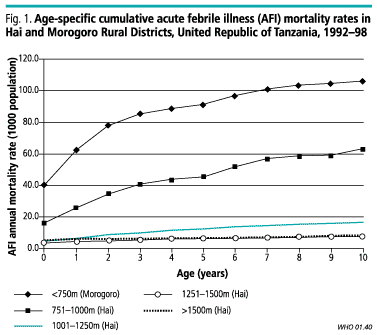Relationship between malaria endemicity and acute febrile illness mortality in children
Editor Editor The relationship between the intensity of malaria transmission and the degree of malaria risk was discussed recently in the Bulletins theme section on malaria (1). In their study in the Lancet of hospital admissions in Kenya and the Gambia, Snow et al. (2) found that the cumulative risk of severe malaria by 5 years of age was higher in areas of low-to-moderate transmission (mesoendemic) than in hyperendemic and holoendemic areas (i.e. medium high and high transmission, respectively). They concluded that in highly endemic areas, interventions that reduce transmission of malaria, and thusimmunity, might lead to changes in both the clinical spectrum of severe disease and the overall burden of severe malaria morbidity. Recent results from the United Republic of Tanzania do not support this assertion.
Since 1992, the Tanzanian Ministry of Health, through the Adult Morbidity and Mortality Project (AMMP), has assessed age and cause-specific mortality in three districts using a demographic surveillance system (DSS). Key informants record all deaths occurring and inform project clinical officers who conduct verbal autopsy interviews (3). The AMMP DSS populations in rural areas live in Morogoro Rural District, a highly malaria endemic area, and Hai District, on the slopes of Mount Kilimanjaro, where the level of transmission of malaria varies between different altitude zones.
We estimated the cumulative risk of death from acute febrile illness (AFI) between July 1992 and June 1998 from infancy to the age of 10 years in the two rural surveillance areas. Villages in Hai were grouped into four transmission zones based on altitude levels measured using a global positioning system: moderately high or mesohyperendemic (7501000 m), moderate or mesoendemic (10011250 m), low moderate or hypoendemic (12511500 m), and non-endemic (>1500 m). Mortality from AFI was compared between all areas and was found to decrease progressively with increasing altitude; older children did not show an increase in mortality as might have been anticipated (Fig. 1). Similarly, in the Muheza District of the United Republic of Tanzania, Ellman et al. (4) compared the prevalence of febrile malaria and anaemia among six groups of villages at different altitudes and with varying parasite prevalence (3384%). These results did not show the inverse relationship between the level of exposure and malaria morbidity observed by Snow et al.

Interpretation of our observations in relation to the long-term effects of control measures that reduce malaria transmission needs caution. Firstly, we do not have data on intensity of transmission of malaria in the different altitude zones of Hai. Since several other factors such as rainfall, vegetation, vector dynamics, and human population density, migration, and behaviour (5) can alter the intensity of transmission, the classification of intensity of transmission based on altitude alone is necessarily crude. Secondly, we assume that the majority of AFI deaths are attributable to malaria. Because of the nature of the verbal autopsy technique, the exact proportion cannot be determined; it is likely to change, depending upon malaria endemicity. However, this implies that our findings underestimate the gap in mortality and risk of death among the transmission zones. Thirdly, the confounding effects of socioeconomic factors and factors related to health services are not taken into account. In spite of these potential shortcomings, however, we believe that the mortality patterns observed in theAMMPdata suggest that malaria mortality is not inversely related to intensity of transmission in stable malaria transmission areas in Africa. Furthermore, AMMP data are community-based and hence not subject to selection bias from health facility use.
The immediate benefits of the use of insecticide-treated bednets (ITNs) in reducing morbidity and mortality in children have been well established. Some researchers have argued that the long-term costs of increased morbidity and mortality (presumed to be caused by reduced immunity attributable to ITN use) counterbalance or even outweigh the short-term benefits in reduced morbidity and mortality (5). The evidence presented here suggests there may not be any long-term adverse effects on mortality of interventions to reduce transmission. 
Daniel Chandramohan,
Brian Greenwood, Jonathan Cox
London School of Hygiene and Tropical Medicine,
London United Kingdom
Robert Mswia
Adult Morbidity and Mortality Project
Ministry of Health, Dar es Salaam
United Republic of Tanzania
Philip Setel
Adult Morbidity and Mortality Project
Ministry of Health
PO Box 65243, Dar es Salaam
United Republic of Tanzania
(address for correspondence) and Department of Diabetes
University of Newcastle upon Tyne
Medical School
Newcastle upon Tyne
United Kingdom
Acknowledgements
The Adult Morbidity and Mortality Project (AMMP) of the Tanzanian Ministry of Health is funded by the UK Department for International Development (DFID) and implemented in partnership with the University of Newcastle upon Tyne, UK. The views expressed are not necessarily those of DFID. The AMMP team contributing to this publication includes: KGMM Alberti, Richard Amaro, Yusuf Hemed, Berlina Job, Judith Kahama, Joel Kalula, Gregory Kibadi, Ayoub Kibao, John Kisima, Henry Kitange, Mary Lewanga, Frederic Macha, Haroun Machibya, Honorati Masanja, Lydia Masayanyika, Mkamba Mashombo, Godwill Massawe, Gabriel Masuki, Ali Mhina, Veronica Mkusa, Ades Moshi, Deo Mtasiwa, Samuel Ngatunga, Mkay Nguluma, Paul Nkulila, Seif Rashid, JJ Rubona, Asha Sankole, Daudi Simba, Nigel Unwin, and David Whiting.
Conflict of interests: none declared.
1. Carter R, Mendis KN, Roberts D. Spatial targeting of interventions against malaria. Bulletin of the World Health Organization, 2000, 78: 14011411.
2. Snow RW et al. Relation between severe malaria morbidity in children and level of Plasmodium falciparum transmission in Africa. Lancet, 1997, 349: 16501654.
3. Kitange H et al. Outlook for survivors of childhood in sub-Saharan Africa: adult mortality in Tanzania. British Medical Journal, 1996, 312: 216220.
4. Ellman R et al. Malaria and anaemia at different altitudes in the Muheza District of Tanzania: childhood morbidity in relation to level of exposure to infection. Annals of Tropical Medicine and Parasitology, 1998, 92: 741753.
5. Trape J, Rogier C. Combating malaria morbidity and mortality by reducing transmission. Parasitology Today, 1996, 12: 236240.
